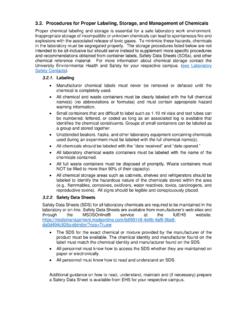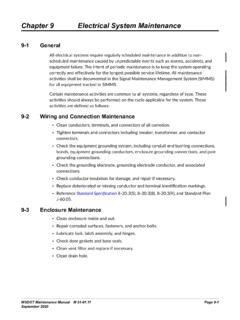Transcription of Hazard Communication - Occupational Safety and Health ...
1 Hazard Communication The Occupational Safety and Health administration (OSHA) Hazard Communication standard (HCS), also known as the employee right-to-know standard, is found at 29 CFR of the general industry standards and incorporated into the construction standard at 29 CFR HCS was developed to protect employees from exposure to hazardous products and chemicals. This standard requires all employers to develop a written program addressing labeling and warning requirements, material Safety data sheets (MSDSs) and employee training on hazardous materials.
2 The standard also requires employers to develop and maintain a list of all hazardous substances in the workplace and a description of the methods the employer will use to inform employees of the hazards related to nonroutine tasks in the workplace. From the initial effective date of this standard, HCS violations have been among the most frequent citations issued by OSHA in the construction and general industries because it can be difficult to comply with all of its administrative requirements. This section discusses the HCS standard s requirements, including those involving employee training.
3 Following this chapter is a sample written program that roofing contractors can adapt and use in their own companies Health and Safety programs. How to Comply The following is a six-step approach for complying with the standard. Although there are only six main steps, each involves many smaller steps. 1. Know the standard. It is up to roofing contractors to understand the elements of this fairly complex standard and become familiar with their responsibilities. This is an employee-right-to-know law employees have the right to know about the standard, the hazardous chemicals and products found in the workplace, and the methods of protecting themselves from chemical exposure.
4 2. Develop a chemical inventory list. A chemical inventory list is included in the sample written program following this chapter. An employer should walk around the office, yard and project sites, recording the product names of all chemicals, along with the manufacturers names, addresses and telephone numbers. Something as simple as a tube of caulking compound is a product that contains chemicals for which an employer must maintain an MSDS and list the product on the chemical inventory. Each chemical s location also should be noted.
5 (This is a good time to properly dispose of half-empty and unneeded cans of paint, adhesive and other materials.) The completed chemical inventory list should be kept with the written program because it may need to be amended as new chemicals are purchased. 3. Label all containers. All containers should be labeled with at least the following information: Identity of the chemical All potential hazards associated with the chemical Manufacturer s name, address and telephone number One common problem facing companies is the use and labeling of portable containers.
6 Portable containers should be dedicated for one specific use and labeled with the identity of the hazardous chemical inside and appropriate Hazard warnings so employees will have general information as to the hazards relating to the chemical. The employer is not required to label portable containers into which hazardous chemicals are transferred from properly labeled containers when the material transferred is for the immediate use of the person performing the transfer. For example, if paint thinner is poured from a labeled original container into a bucket for the purpose of cleaning some parts, the bucket does not need a label if the person transferring the thinner is the one who will use it immediately.
7 OSHA states containers of this type do not need to be labeled if the entire contents are used in one shift by only one person, with the contents being used completely or returned to their original containers. The containers cannot be passed from one employee to another, and employees cannot leave unlabeled, partially filled containers overnight. Labels are available from any Safety supply company. For maximum employee comprehension, labels should be as simple as possible. One style of labeling should be used consistently.
8 Color-coded labels accompanied with numbers and pictures or icons are helpful when there are crew members who do not read English. 4. Obtain MSDSs. An MSDS is needed for each chemical at the workplace. If an MSDS is not received with a shipment, the manufacturer should be contacted to request one for inclusion in the MSDS file. A sample MSDS request letter is included in this chapter, and all MSDS request letters should be retained as evidence of due diligence to obtain the required MSDS. 5. Develop a written program.
9 Many contractors either neglect to develop a written program at all or fail to include the minimum requirements. Each written program must contain the following information: Container-labeling information Material Safety data sheets Methods of training Chemical inventory lists hazards of nonroutine tasks Some companies choose to incorporate the program s written text, chemical inventory list and all MSDSs pertinent to their operations together in one binder. For smaller companies with limited types of roofing operations, this may be adequate.
10 Larger, more diverse companies may want to develop several written programs, each pertaining to a separate roofing operation or application. In such cases, the written text will be the same for each program, but the chemical inventory list and MSDSs will vary. For example, because most built-up roofing projects require the same basic materials, a roofing contractor can develop one written program including text, chemical inventory list and MSDSs for built-up roofing operations. The same can be done for sheet metal projects, steep-slope projects and so on.













